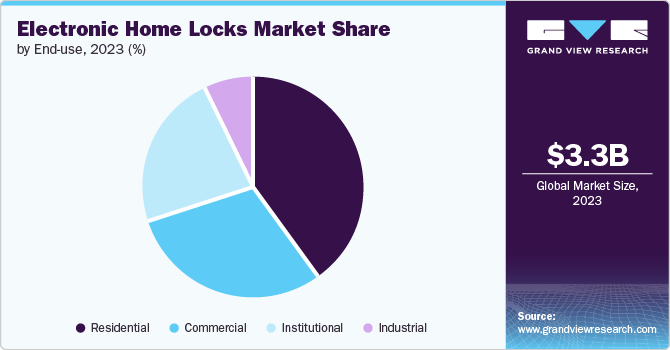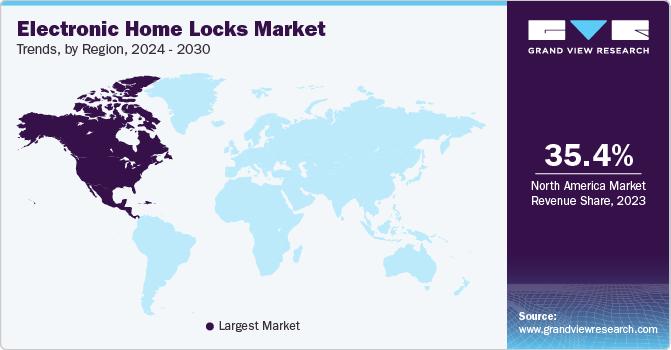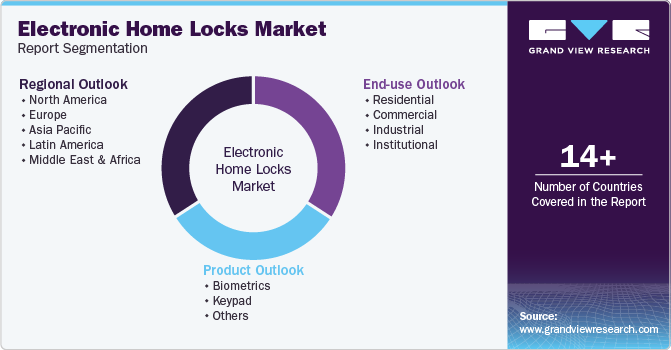
Electronic Home Locks Market Size, Share & Trends Analysis Report By Product (Biometrics, Keypad, Others), By End-use (Residential, Industrial, Commercial, Institutional), By Region, And Segment Forecasts, 2024 - 2030
- Report ID: GVR-3-68038-370-6
- Number of Report Pages: 100
- Format: PDF, Horizon Databook
- Historical Range: 2018 - 2022
- Forecast Period: 2024 - 2030
- Industry: Consumer Goods
Electronic Home Locks Market Size & Trends
The global electronic home locks market size was valued at USD 3.29 billion in 2023 and is projected to grow at a CAGR of 8.1% from 2024 to 2030. The increasing awareness and concern about home security drives market growth. As burglary and home invasion rates continue to be a significant concern worldwide, homeowners seek more advanced and reliable security solutions. Electronic home locks offer enhanced security features compared to traditional locks, including keyless entry, remote access, and integration with home security systems. These features provide homeowners with greater control and peace of mind, knowing that their homes are more secure and that they can monitor and manage access remotely.

Technological advancements have also played a crucial role in the growing popularity of electronic home locks. Innovations such as smart locks, which can be controlled via smartphones and connected to home automation systems, are particularly appealing to tech-savvy consumers. The convenience of locking or unlocking doors from anywhere, granting temporary access to guests or service providers, and receiving real-time notifications about entry and exit activities adds significant value to these products. Additionally, the increasing adoption of Internet of Things (IoT) technology has facilitated the integration of electronic locks with other smart home devices, creating a seamless and interconnected home environment.
Another factor contributing to the increased demand is the rising trend of smart homes and the overall growth of the smart home market. As more consumers invest in smart home devices and systems, electronic home locks are often seen as a natural extension of this ecosystem. They complement other smart home technologies such as security cameras, alarm systems, and smart lighting, creating a comprehensive and cohesive security solution. The appeal of having a fully automated and remotely manageable home security system is driving more homeowners to opt for electronic locks.
Finally, the competitive pricing and increased availability of electronic home locks have made them more accessible to a broader range of consumers. As the market has expanded, economies of scale have reduced manufacturing costs, allowing for more affordable options without compromising on quality and features. The availability of various models catering to different price points and user needs has made electronic locks a viable option for many homeowners, contributing to their growing demand globally.
Product Insights
Keypad segment held the largest market revenue share of 45.8% in 2023. The demand for the keypad segment in the electronic home lock market is rising due to its convenience, security, and technological advancements. Keypad locks offer users the ease of not needing physical keys, reducing the risk of lost or stolen keys and allowing easy access management for multiple users. They also integrate well with smart home systems, providing enhanced security features such as temporary access codes and activity logs, which benifits to tech-savvy consumers.
The biometric segment is projected to grow at the fastest CAGR of 9.1% over the forecast period. Biometric door locks use facial recognition, palm recognition, iris recognition, and fingerprint recognition technologies. These advanced attributes improve security and convenience in comparison to standard lock-and-key systems. Biometric locks' simpler installation process makes them more convenient for customers. They remove the need for physical keys and enable remote control via smartphones or access codes. Due to a rise in housebreak incidents, individuals are opting for safer alternatives. Biometric locks offer an additional level of security due to their distinct verification techniques.
End-use Insights
Residential segment dominated the market in 2023. The growing concern for home security has driven homeowners to seek advanced security solutions, with electronic locks offering enhanced protection through features like remote access, biometric recognition, and real-time alerts. The increasing awareness of the benefits of smart security solutions, coupled with the ease of installation and use, has further fueled their adoption. Moreover, the ongoing urbanization and increased disposable incomes have led to a higher willingness to invest in advanced home security systems, making electronic locks a preferred option in modern residential properties.

The commercial segment is projected to grow with the fastest CAGR over the forecast period. The rising need for enhanced security and convenience in businesses and multi-tenant properties drives the segment growth. Commercial establishments, such as office buildings, hotels, and rental properties, require robust security systems to protect valuable assets, sensitive information, and ensure the safety of occupants. Electronic home locks offer advanced features like remote access, real-time monitoring, and integration with other security systems, making them an attractive option for commercial use. Additionally, the growing trend of smart buildings and the adoption of Internet of Things (IoT) technologies are driving the commercial sector to upgrade from traditional locks to sophisticated electronic locking systems, which provide better control, management, and user experience.
Regional Insights
North America electronic home locks market held the largest market revenue share of 35.4% in 2023. The primary driver is the growing concern for home security and safety among residents, coupled with advancements in smart home technology. Homeowners increasingly opt for electronic locks due to their convenience, enhanced security features, and integration with other smart home devices. Additionally, the rise in urbanization and the higher disposable incomes of consumers have contributed to the adoption of these advanced locking systems.

U.S. Electronic Home Locks Market Trends
U.S. market is witnessed as lucrative in this industry. The increasing focus on home security and safety, as homeowners seek advanced solutions to protect their properties. The convenience and enhanced control offered by smart locks, which can be operated remotely via smartphones and integrated with other smart home devices, are also appealing to tech-savvy consumers. Additionally, the surge in smart home adoption, driven by advancements in IoT technology and the proliferation of connected devices, has contributed to this trend.
Europe Electronic Home Locks Market Trends
Europe market is witnessing a prominent growth in this industry. The increasing concerns about home security have driven homeowners to seek more advanced and reliable solutions, and electronic locks offer enhanced security features compared to traditional locks. The growing trend of smart home technologies across Europe has spurred interest in interconnected devices, with electronic locks being a crucial component of smart home ecosystems. Additionally, the convenience of electronic locks, such as keyless entry and remote access, aligns with the modern lifestyle of European consumers who prioritize ease of use and technological integration. Furthermore, urbanization and the rise in rental properties have increased the need for flexible and secure access solutions, making electronic locks an attractive option for both property owners and tenants.
The UK electronic home locks market is projected to grow significantly in the coming years. Modern technologies such as Bluetooth and facial recognition have greatly increased their popularity. The increasing number of smartphone users has grown in popularity due to their ability to improve their security and convenience. These locks provide wireless connectivity, enabling users to receive security notifications on their linked devices and observe their residences from a distance.
Asia Pacific Electronic Home Locks Market Trends
Asia Pacific electronic home locks market is projected to grow at the fastest CAGR over the forecast period. The increasing tourism industry in the Asia Pacific region is fueling the hospitality sector's need for electronic home locks. These locks are changing the hospitality industry with a smooth and safe guest experience. Hotels and vacation rentals increasingly use these locks to make the check-in process more efficient. Visitors can utilize digital keys with their smartphones, which improves convenience and removes the need for physical keycards. Furthermore, hotel management can enhance operational efficiency by remotely monitoring and managing room access.
India electronic home locks market is projected to grow over the forecast period. The demand for electronic home locks in India is rising due to several factors. The rapid urbanization and increasing number of nuclear families have led to a heightened focus on home security. Additionally, the surge in smart home ecosystems, where various devices are interconnected and controlled through smartphones, has boosted interest in advanced security solutions. The real estate sector's adoption of smart technologies in new residential projects further accelerates this trend as homebuyers increasingly seek properties equipped with modern security systems.
Key Electronic Home Locks Company Insights
Some of the key companies in the electronic home locks market include Allegion; Salto Systems, S.L.; Honeywell International Inc.; dormakaba Group; Spectrum Brands, Inc.; and others.
-
Allegion provides innovative locking systems which utilize electronic components and technology manage access control on doors or entrance points. As compared to traditional locks that needs physical keys, these system delivers improved functionality and handiness through electronic authentication methods such keypads and credential readers.
-
Salto Systems, S.L. provides a wide range of electronic locks which allows users to unlock doors with a range of security pin and mobile technologies. These innovative and secure locking systems are easy to install as it is a completely wireless networked smart electronic locking solution.
Key Electronic Home Locks Companies:
The following are the leading companies in the electronic home locks market. These companies collectively hold the largest market share and dictate industry trends.
- Vivint, Inc.
- Honeywell International Inc.
- Allegion
- dormakaba Group
- Godrej.com
- Spectrum Brands, Inc.
- Samsung
- Salto Systems, S.L.
- Master Lock Company LLC
- MIWA Lock Co.
Recent Developments
-
In March 2023, Allegion announced the launch of the Schlage XE360 Series Wireless Locks designed for multifamily housing applications. These new locks provide enhanced security and convenience for property owners and residents. This launch underscores Allegion's commitment to delivering innovative security solutions that improve the safety and functionality of multifamily properties.
-
In May 2023, Aavgo announced a partnership with MIWA Lock Systems to integrate their technologies, enhancing contactless guest experiences in hotels. This collaboration combines Aavgo's 360 Platform and Smart Reception with MIWA's advanced locking systems, allowing seamless digital check-in and check-out processes. The integration aims to reduce operational costs by up to 35%, improve guest satisfaction, and boost hotel profitability.
Electronic Home Locks Market Report Scope
|
Report Attribute |
Details |
|
Market size value in 2024 |
USD 3.55 billion |
|
Revenue forecast in 2030 |
USD 5.68 billion |
|
Growth Rate |
CAGR of 8.1% from 2024 to 2030 |
|
Base year for estimation |
2023 |
|
Historical data |
2018 - 2022 |
|
Forecast period |
2024 - 2030 |
|
Report updated |
September 2024 |
|
Quantitative units |
Revenue in USD million and CAGR from 2024 to 2030 |
|
Report coverage |
Revenue forecast, company ranking, competitive landscape, growth factors, and trends |
|
Segments covered |
Product, end-use, region |
|
Regional scope |
North America; Europe; Asia Pacific; Latin America; MEA |
|
Country scope |
U.S.; Canada; UK; Germany; Italy; Spain; France; China; India; Japan; Australia; South Korea; Brazil; South Africa; UAE. |
|
Key companies profiled |
Vivint, Inc.; Honeywell International Inc.; Allegion; dormakaba Group; Godrej.com; Spectrum Brands, Inc.; Samsung; Salto Systems, S.L.; Master Lock Company LLC; MIWA Lock Co. |
|
Customization scope |
Free report customization (equivalent up to 8 analysts working days) with purchase. Addition or alteration to country, regional & segment scope. |
|
Pricing and purchase options |
Avail customized purchase options to meet your exact research needs. Explore purchase options |
Global Electronic Home Locks Market Report Segmentation
This report forecasts revenue growth at global, regional, and country levels and provides an analysis of the latest industry trends in each of the sub-segments from 2018 to 2030. For this study, Grand View Research has segmented the global electronic home locks market report based on product, end-use, and region:

-
Product Outlook (Revenue, USD Million, 2018 - 2030)
-
Biometrics
-
Keypad
-
Others
-
-
End-use Outlook (Revenue, USD Million, 2018 - 2030)
-
Residential
-
Commercial
-
Industrial
-
Institutional
-
-
Regional Outlook (Revenue, USD Million, 2018 - 2030)
-
North America
-
U.S.
-
Canada
-
-
Europe
-
UK
-
Germany
-
France
-
Italy
-
Spain
-
-
Asia Pacific
-
China
-
India
-
Japan
-
Australia
-
South Korea
-
-
Latin America
-
Brazil
-
-
Middle East and Africa (MEA)
-
South Africa
-
UAE
-
-
We are committed towards customer satisfaction, and quality service.
"The quality of research they have done for us has been excellent."




